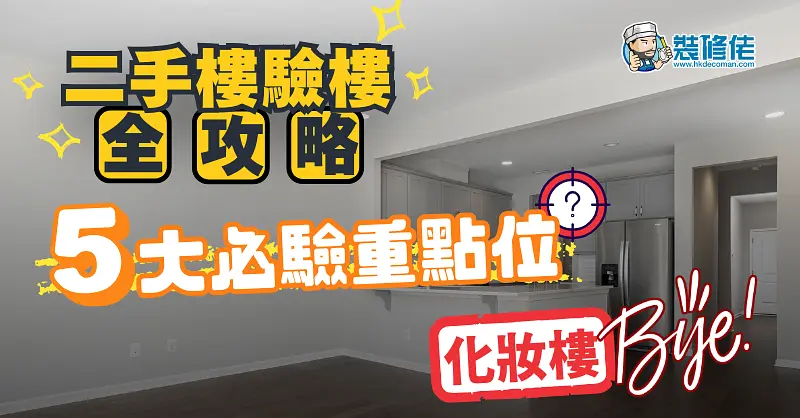Second-Hand Property Inspection: A Buyer's Guide
Listen to the blog audio:

Purchasing a desirable second-hand property is an important step for many to settle down and build a career. However, unlike new properties that come with a warranty period, second-hand property transactions generally follow the 'as-is' purchase principle, meaning that after signing the contract, the responsibility for repairing any defects in the unit falls on the new owner. Therefore, conducting a thorough inspection before the transaction is completed is extremely important. Renovation Expert provides a guide for inspecting second-hand properties to help new owners inspect wisely and move in with peace of mind.
Key Concept: Who Bears the Responsibility of "As Is" Purchase?
Before delving into the details of property inspection, it is essential to thoroughly understand the core concept of second-hand property transactions—"As is" purchase. This clause signifies that at the moment of signing the purchase contract, the buyer has agreed to all the current conditions of the property.
- Difference from New Properties: Developers selling new properties typically provide a "defect rectification" warranty period of 6 months or even longer. However, sellers of second-hand properties have no responsibility for repairs. Issues discovered after the handover, such as water leakage, hollow tiles, or electrical appliance damage, all repair costs are solely borne by the buyer.
- Risks of "Makeover Properties": Because of this, there are some "makeover properties" in the market, where owners use simple paint or renovations before selling to cleverly conceal serious problems like original seepage, wall cracks, or fake switches. If buyers fail to detect these before signing the contract, the future repair costs may far exceed expectations.
- Golden Timing for Property Inspection: Generally, buyers have two main opportunities for property inspection after signing the provisional purchase agreement. The first is usually for the bank to conduct a property valuation; the second, and most critical, is the final inspection conducted one to two days before the official completion date (handover), to confirm that the unit's condition is consistent with that at the time of signing the contract.
Transaction Process: Master the Golden Time for Property Inspection
After understanding the importance of property inspection, let's take a look at the entire second-hand property transaction and inspection process to ensure you are clear about your rights and responsibilities at each stage.
- Signing the Provisional Sale and Purchase Agreement: After the buyer and seller successfully negotiate the price, they will sign the "Provisional Sale and Purchase Agreement," and the buyer needs to pay the "initial deposit." This stage is crucial for establishing the transaction terms, especially regarding the inclusion of furniture and appliances; a detailed "furniture list" should be signed at this time.
- Handling Bank Mortgage and Signing the Formal Contract: The buyer uses the provisional agreement to apply for a mortgage from the bank. Subsequently, the lawyers for both parties will draft and have the buyer and seller sign the "Formal Sale and Purchase Agreement," at which point the buyer needs to pay the "main deposit."
- Arranging Pre-Handover Property Inspection: Before the formal completion date, the buyer should coordinate with the real estate agent to schedule a time for the final inspection. This is the last opportunity to identify issues and communicate with the seller.
- Formal Handover: After the property inspection is satisfactory, on the completion day, the lawyers for the buyer and seller will handle the remaining payments and property deed documents. Once the buyer obtains the keys from the lawyer's office, the transaction is officially completed, and the buyer becomes the new owner of the unit.

Inspection Core: Unpacking 5 Common Defect Areas
1. Water Leakage
Water leakage is the most troublesome issue in second-hand properties, with high repair costs and long-lasting consequences.
- Ceilings and Walls: Carefully inspect all ceilings, wall corners, areas below window sills, and air conditioning units for any water stains, marks, peeling paint, or signs of mold and discoloration.
- Kitchen and Bathroom Interiors: Open kitchen cabinets and bathroom vanity cabinets, and use your nose to check for any musty smells. Use your hand or a tissue to touch the pipe connections under the sink to check for leaks.
- Behind False Ceilings: If there are false ceilings, be sure to lift them to inspect for water marks on pipes and the concrete ceiling.
- Waterproofing and Drainage Tests: Fill the shower area or bathtub with water, then release it all at once to observe if the drainage is smooth. Also, check if the floor slope is adequate, ensuring water flows naturally to the drain and does not accumulate in corners. You can pour a small amount of water on the floor for testing.
2. Walls and Structure
Structural issues are difficult to resolve permanently and should never be taken lightly.
- Walls and Tiles: Use an antenna rod or coin to gently tap the walls and floor tiles; a clear sound indicates normal conditions, while a dull "thud" suggests "hollow tiles." Hollow tiles mean the cement behind is not fully filled, making them prone to cracking or peeling under pressure or thermal expansion, posing a home safety hazard. Pay special attention to hollow tile issues in waterproof areas like kitchens and bathrooms.
- Crack Observation: Look for cracks in walls, beams, or floors. If the cracks are diagonal or show signs of widening, they may indicate structural problems, and professional advice should be sought.
- Baseboards: Check wooden baseboards for bulging, blackening, or deformation, as these are clear warning signs of water seepage at the wall base.
3. Doors and Windows
The condition of doors and windows directly affects living comfort and safety.
- Smoothness of Opening and Closing: Open and close all doors and windows several times to ensure the process is smooth and unobstructed, and that the locks operate normally.
- Sealing Check: After closing the doors and windows, try pushing hard to check if they are secure. You can also try inserting a card into the gaps around the doors and windows; if it slides in easily, it indicates the gaps are too large, which can lead to drafts and water leakage during the rainy season.
- Waterproof Seals and Glass: Check the waterproof seals around the windows for any hardening, cracking, or shrinkage. Also, look for any cracks or chips in the glass itself.
4. Water and Electrical Systems
Water and electricity are the nervous system of a home; discovering issues after moving in can be extremely inconvenient.
- Electrical Outlets: Use a plug tester with indicator lights to test all electrical outlets in the house one by one, ensuring they are functioning properly and avoiding any "fake outlets" that are just for show.
- Water Supply and Drainage Pipes: Turn on all faucets to test if the water pressure is normal. As mentioned earlier, focus on checking for any leaks in the drainage pipes.
5. Furniture and Appliances
If the seller has promised to leave furniture and appliances, this step is crucial for protecting yourself.
- Sign a "Furniture Inventory": When signing the provisional sales and purchase agreement, be sure to separately sign a detailed "furniture inventory" with the seller. The list should clearly specify the brand, location, and a brief description of the appearance of each piece of furniture and appliance, and it's best to take photos of the items as evidence. This inventory is a legally binding attachment that can prevent disputes later on.
- On-site Verification and Testing: On the day of the property inspection, take out this inventory and verify one by one that the brands, models, and quantities of the left-behind items are completely consistent. At the same time, activate all included appliances, such as air conditioners (test cooling), water heaters (test hot water), stoves, range hoods, etc., to ensure they are all operating normally.

Precautions
- Hire Professionals: If you lack confidence in the building's structure, or the unit is older, it is recommended to hire a qualified professional for the inspection. They possess the relevant instruments and knowledge to more accurately detect hidden problems that are difficult for the average person to notice.
- What to Do If Problems Are Found: If problems are discovered during the final inspection (such as damaged electrical appliances, new leaks), you should immediately take photos for evidence and notify your lawyer and real estate agent as soon as possible. Through them, negotiate a solution with the seller (such as requesting repairs or compensation).
- Special Property Considerations: If you are purchasing a village house, before the inspection, you should check the land registry to confirm whether the property structure has any illegal constructions (unauthorized structures), as well as issues like right of way and ownership, to avoid endless legal troubles in the future.
[Book Home Clinic Service Immediately]
From renovation quotes to before and after moving in, comprehensive one-stop support!
>> Get Free Renovation Quote: https://hkdecoman.com/measure
>> Book a Home Clinic Appointment (Building Inspection/Cleaning/Repair): https://clinic.deco-x.com/
Specialized Sections for Various Housing Types:
>> Public Housing https://decoman-publichousing.com/
>> Private Housing https://decoman-privatehousing.com/
>> New Properties https://decoman-newproperties.com/
>> Tangyang Building https://decoman-tenement.com/
================================================================
*** This article is reproduced with permission from Renovation Man ***
